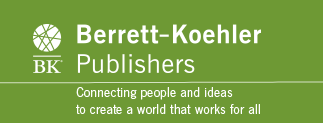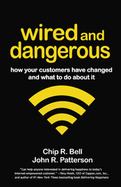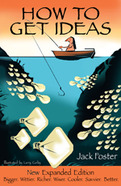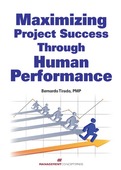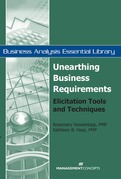2011
2007
Jack Foster's simple five-step technique for solving problems and getting ideas takes the mystery and anxiety out of the idea-generating process. It's a proven process that works. You'll learn to condition your mind to become "idea-prone," utilize your sense of humor, develop your curiosity, visualize your goals, rethink your thinking, and overcome your fear of rejection.
This expanded edition of the inspiring and enlightening classic features new information on how to turn failures to your advantage and how to create a rich, idea-inducing environment. Dozens of new examples and real life stories show that anyone can learn to get more and better ideas.
- A revised and expanded edition of a bestselling classic--more than 90,000 copies sold of the first edition
- This new edition includes to completely new chapters
- Cleverly weaves together exercises, stories, quotations, and illustrations to offer a fun and practical guide to idea generation
2010
Wheatley does not offer the usual feel-good, rah-rah messages. Instead, she focuses on the situations, feelings, and challenges that can, over time, cause us to lose heart or lose our way. Perseverance is a day-by-day decision not to give up. We have to notice the moments when we feel lost or overwhelmed or betrayed or exhausted and note how we respond to them. And we have to notice the rewarding times, when we experience the joy of working together on something hard but worthwhile, when we realize we've made a small difference.
In a series of concise and compassionate essays Wheately names a behavior or dynamic—such as fearlessness, guilt, joy, jealousy—that supports or impedes our efforts to persevere. She puts each in a broader human or timeless perspective, offering ways to either live by or transcend each one. These essays are self-contained—you can thumb through the book and find what attracts you in the moment. Perseverance helps you to see yourself and your situation clearly and assume responsibility for changing a situation or our reaction to it if it's one that troubles us. There deliberately are no examples of other people or their experiences. You are the example—your personal experiences are the basis for change.
In addition to Wheatley's graceful essays there are poems and quotations drawn from traditions and cultures around the world and throughout history. The book is deeply grounded spiritually, accessing human experience and wisdom from many sources. This grounding and inclusiveness support the essential message—human being throughout time have persevered. We're just the most recent ones to face these challenges, and we can meet them as those who came before us did. As Wheatley quotes the elders of the Hopi Nation: “We are the ones we have been waiting for.”
-
By the bestselling author of Leadership and the New Science and Turning to One Another
-
Thoughtful, compassionate reflections on how we can carry on with joy despite difficulties, challenges, and disappointments
-
Illuminated by both beautiful original paintings and by poems and quotations from a variety of traditions and cultures
In this inspiring and beautifully illustrated book, bestselling author Margaret Wheatley offers guidance to people everywhere for how to persevere through challenges in their personal lives, with their families, at their workplaces, in their communities, and in their struggles to make a better world. She provides hope, wisdom, and perspective for learning the discipline of perseverance.
Wheatley does not offer the usual feel-good, rah-rah messages. Instead, she focuses on the situations, feelings, and challenges that can, over time, cause us to lose heart or lose our way. Perseverance is a day-by-day decision not to give up. We have to notice the moments when we feel lost or overwhelmed or betrayed or exhausted and note how we respond to them. And we have to notice the rewarding times, when we experience the joy of working together on something hard but worthwhile, when we realize weve made a small difference.
In a series of concise and compassionate essays Wheately names a behavior or dynamicsuch as fearlessness, guilt, joy, jealousythat supports or impedes our efforts to persevere. She puts each in a broader human or timeless perspective, offering ways to either live by or transcend each one. These essays are self-containedyou can thumb through the book and find what attracts you in the moment. Perseverance helps you to see yourself and your situation clearly and assume responsibility for changing a situation or our reaction to it if its one that troubles us. There deliberately are no examples of other people or their experiences. You are the exampleyour personal experiences are the basis for change.
In addition to Wheatleys graceful essays there are poems and quotations drawn from traditions and cultures around the world and throughout history. The book is deeply grounded spiritually, accessing human experience and wisdom from many sources. This grounding and inclusiveness support the essential messagehuman being throughout time have persevered. Were just the most recent ones to face these challenges, and we can meet them as those who came before us did. As Wheatley quotes the elders of the Hopi Nation: We are the ones we have been waiting for.
As employment law attorney Glenn Solomon explains, the overwhelming majority of Americans are subject to "at-will" employment: they are hired-and can be fired-at their employer's will. While there are a few specific kinds of discriminatory termination (based on age, sex, race, etc.) prohibited by law, it is difficult to prove such discrimination in court.
Solomon argues that the at-will rule is inherently unjust, since it leaves the livelihood of most Americans subject to their employers' whims. How can workers fight back? Drawing on his two decades of legal experience, Solomon discusses in detail four exceptions to the at-will rule, critiquing their effectiveness and explaining precisely how workers might be able to take advantage of them. He describes how workers can leverage what few rights they do have under the existing system, including what to consider when deciding whether or not to sue your employer and what to expect if you do decide to sue, using an actual wrongful termination case to illustrate. And he recommends an alternative to the at-will rule that protects the rights of both workers and employers.
- The rulebook for the game of work that describes how one rule, the at-will rule, trumps all the other rules and can undermine your economic security and your other employment-related rights
- Explores what options exist for getting around the at-will rule and for combating unjust "at will" terminations and presents a viable alternative that more fairly balances the rights of workers and employers
- Written by an employment lawyer with many years of experience representing both employees and employers
Project management is often defined by processes and methodology, but projects are accomplished by people. Successfully leading those people is the core of a project manager's job. Even the seasoned project manager will encounter situations that present unique leadership challenges.
Bernardo Tirado offers a clear path to help develop leadership skills within the project management framework. Using a hands-on, practical approach, he presents a model for taking any project manager's leadership skills to the next level. His model focuses on techniques to develop and apply three areas of awareness—self-awareness, awareness of team dynamics, and organizational or “political” awareness. The first three parts of the book provide tools for understanding and influencing behavior and the last part brings the three types of awareness together in a case study.
Exercises throughout make the book interactive and offer a continual assessment of the reader's progress.
Learn how the business analyst works collaboratively with the project manager and other core team members to create plans that customize elicitation activities to the unique needs of the project. The author presents techniques used by successful business analysts and defines key business analysis terms.
Examine the principles and practices for pragmatic, effective requirements elicitation and learn how to work collaboratively with project members and other core team members. Discover the steps necessary to create customized elicitation activities for the unique needs of each project.
